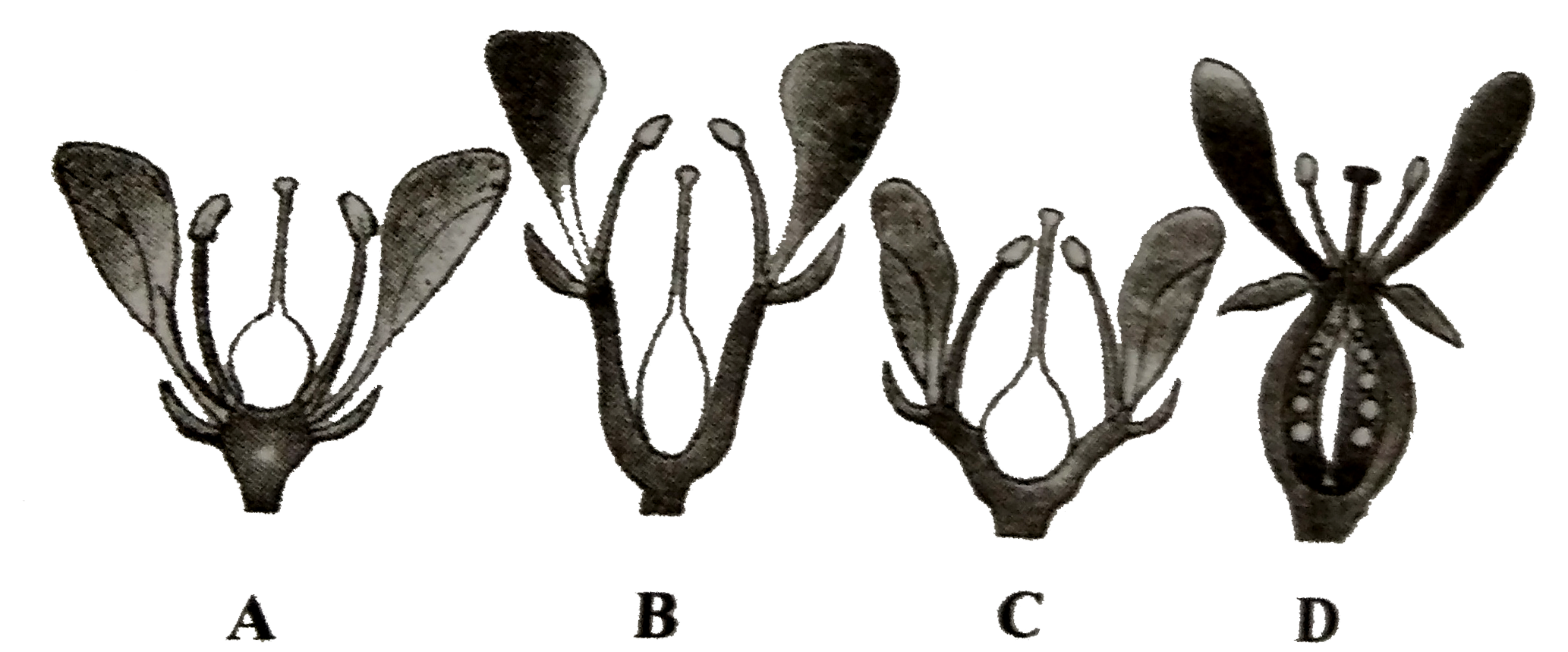Describe different kinds of flowers on the basis of relative position of floral parts on the thalamus.
To describe different kinds of flowers based on the relative position of floral parts on the thalamus, we can categorize them into three main types: hypogynous, perigynous, and epigynous flowers. Here’s a step-by-step explanation of each type:
Step 1: Hypogynous Flowers
- Definition: In hypogynous flowers, the ovary is situated at the highest position on the thalamus.
- Arrangement: The other floral parts (such as petals, sepals, and stamens) are located below the ovary.
- Examples: Common examples of hypogynous flowers include China Rose (Hibiscus rosa-sinensis) and Mustard (Brassica).
Step 2: Perigynous Flowers
- Definition: Perigynous flowers have a half-inferior ovary.
- Arrangement: In this type, the ovary is positioned at the center of the flower, and the other floral parts are arranged in a circular manner around the ovary, forming a rim.
- Examples: Examples of perigynous flowers include Plum (Prunus domestica) and Peach (Prunus persica).
Step 3: Epigynous Flowers
- Definition: Epigynous flowers feature an inferior ovary.
- Arrangement: In these flowers, the thalamus grows around the ovary, and the other floral parts are located above the ovary.
- Examples: Common examples of epigynous flowers are Guava (Psidium guajava) and Kumbha (Cucurbita).
Summary
To summarize, flowers can be classified based on the position of their floral parts relative to the ovary as follows:
1. Hypogynous: Ovary at the top, with other parts below (e.g., China Rose, Mustard).
2. Perigynous: Ovary in the center, with parts around it (e.g., Plum, Peach).
3. Epigynous: Ovary at the bottom, with parts above it (e.g., Guava, Kumbha).
- Definition: In hypogynous flowers, the ovary is situated at the highest position on the thalamus.
- Arrangement: The other floral parts (such as petals, sepals, and stamens) are located below the ovary.
- Examples: Common examples of hypogynous flowers include China Rose (Hibiscus rosa-sinensis) and Mustard (Brassica).
- Definition: Perigynous flowers have a half-inferior ovary.
- Arrangement: In this type, the ovary is positioned at the center of the flower, and the other floral parts are arranged in a circular manner around the ovary, forming a rim.
- Examples: Examples of perigynous flowers include Plum (Prunus domestica) and Peach (Prunus persica).
- Definition: Epigynous flowers feature an inferior ovary.
- Arrangement: In these flowers, the thalamus grows around the ovary, and the other floral parts are located above the ovary.
- Examples: Common examples of epigynous flowers are Guava (Psidium guajava) and Kumbha (Cucurbita).
To summarize, flowers can be classified based on the position of their floral parts relative to the ovary as follows:
1. Hypogynous: Ovary at the top, with other parts below (e.g., China Rose, Mustard).
2. Perigynous: Ovary in the center, with parts around it (e.g., Plum, Peach).
3. Epigynous: Ovary at the bottom, with parts above it (e.g., Guava, Kumbha).
Topper's Solved these Questions
- BOOK - ICSECHAPTER - SAMPLE QUESTION PAPER 3EXERCISE - SECTION - C6videos
SAMPLE QUESTION PAPER 3
- BOOK - ICSECHAPTER - SAMPLE QUESTION PAPER 3EXERCISE - SECTION - A9videos
SAMPLE QUESTION PAPER 3
- BOOK - ICSECHAPTER - SAMPLE QUESTION PAPER 2 EXERCISE - PART-II SECTION - C6videos
SAMPLE QUESTION PAPER 2
- BOOK - ICSECHAPTER - SAMPLE QUESTION PAPER 4 EXERCISE - Part - II Section - C9videos
SAMPLE QUESTION PAPER 4
Similar Questions
Describe different types of neurons on the basis of their functions.
View SolutionRefer to the given figures, showing relative position of different floral parts on the thalamus and select the correct option .
 View Solution
View SolutionDescribe different types of animals on the basis of nature of nitrogenous wastes excreted by them.
View SolutionCorrect position of floral parts over thalamus in mustard plant is:
View SolutionDescribe the different groups of non-flowering plants.
View SolutionDescribe the functions of different parts of a flower
View SolutionDescribe the arrangement of floral members in relation to their insertion on thalamus?
View SolutionDescribe the arrangement of floral members in relation to their insertion on thalamus
View SolutionName the different parts of a flower from outside to the centre.
View SolutionGive one difference between each of the following pairs on the basis of what is given in the brackets:
Metaphase and Anaphase (position of chromatids)View Solution

